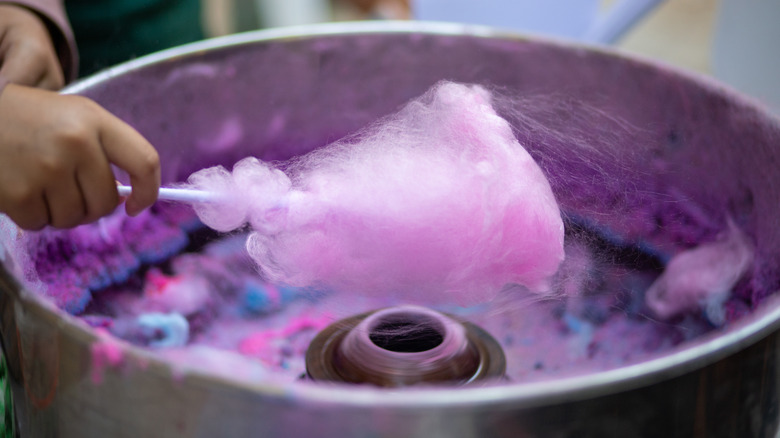The High-Tech Way Commercial Cotton Candy Is Made
Fewer food items evoke a stronger sense of nostalgia than cotton candy. These colorful wisps of spun sugar are a staple of state fairs and carnivals across the country and are sure to bring back memories of spending the day outdoors spinning on the carousel, petting goats, and pony rides. But how do they make these sweet, whimsical treats and why is cotton candy so fluffy? After all, these puffs of sugar look no more solid than clouds but stimulate the senses with bright colors and saccharine flavors.
It turns out, it doesn't really take much to make this cloud-like confectionery creation. Cotton candy is essentially just sugar, coloring, and air, according to Gold Medal. The sugar is spun around at very high heat until it is melted and broken into wispy cotton threads that are thinner than the average human hair, according to Portable Press. While the process of manufacturing cotton candy in large quantities requires essentially the same ingredients as making small batches, commercial cotton candy requires a little more high-tech equipment to keep up with the demand.
Commercial cotton candy is made with big industrial machines
Large batches of cotton candy are made using a commercial cotton candy machine, which does two very important things: gets very hot and spins very fast. The very first cotton candy machine was invented by none other than a dentist named Dr. William Morrison, according to Portable Press. Setting aside the obvious conspiracy theories as to why a dentist would create a cavity-inducing candy made of pure sugar, let's get into the history of the invention.
Portable Press reports that Dr. Morrison teamed up with the candy-maker John C. Wharton to make a machine that could heat sugar and then push the melted pieces through a fine screen that would pull the sugar into fine threads. Today, modern industrial machines can make up to thousands of revolutions per minute and heat up to over 300 degrees Fahrenheit, according to the Food Network's "Unwrapped".
The colored, flavored sugar crystals are poured into the industrial tub, where it is spun around the heated center and quickly melted down before it is forced through the fine holes of the screen. Once the melted sugar hits the air, it hardens into the tasty thin threads we know and love. The heat and speed of spin allow places like carnivals, state fairs, and factories to churn out cotton candy at a high volume between two and three servings per minute, according to Chicago Tribune.
You can make your own cotton candy at home
However, while commercial cotton candy makers might require big industrial machines, you can also make your own batch of cotton candy right at home, with no machinery required. All you really need is parchment paper, a whisk, salt, corn syrup, food coloring, cooking oil, and plenty of sugar, according to the Candy Club.
To quickly whip up your own batch of homemade spun sugar, all you need to do is combine the sugar, corn syrup, water, and salt into a pot and heat it on the stove up to 320 degrees Fahrenheit until the sugar is melted. Once that is done, remove the pot from the stove and transfer the melted sugar concoction into a heat-safe bowl. Then, take the whisk and spin the strands of sugar across the parchment paper until the threads start to thicken into a cotton candy-like consistency. Finally, simply spin the threads onto a popsicle stick or cone, and voila! You'll be able to enjoy your very own carnival-quality cotton candy right at home.


